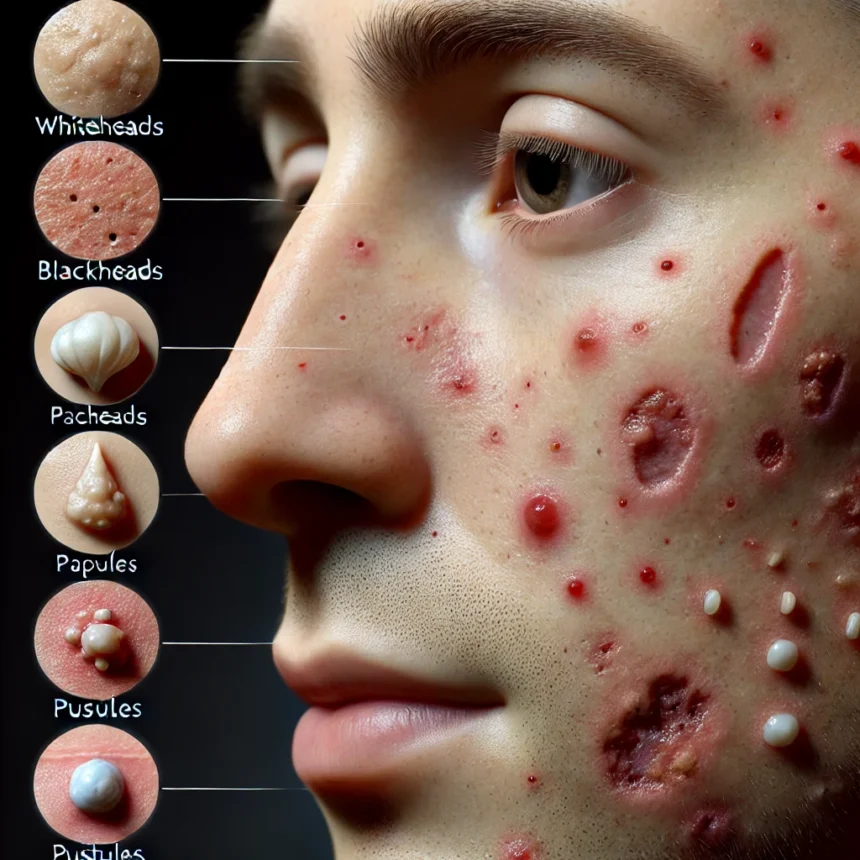Acne can generally be classified into two main categories: non-inflammatory acne and inflammatory acne.
Inflammatory acne is often more severe and typically requires consultation with a healthcare provider for proper treatment.
Below, we explore the most common types of acne, their causes, and characteristics.
Non-Inflammatory Acne

Whiteheads
Whiteheads, also known as closed comedones, are small, white or flesh-colored bumps.
These are formed when dead skin cells, oil, and debris clog the pores. Unlike blackheads, whiteheads remain closed at the surface, trapping the buildup inside.
This type of acne is common and can often be treated with over-the-counter products containing ingredients like salicylic acid or benzoyl peroxide.
Causes:
Accumulation of dead skin cells
Excessive oil production
Poor hygiene or inadequate cleansing routine

Blackheads
Blackheads, or open comedones, are small, dark-colored spots that appear when pores become clogged with a mixture of sebum and dead skin cells.
Unlike whiteheads, the pore remains open, exposing the clog to air.
This exposure causes oxidation, giving the clog its dark appearance.
Causes:
Excess oil and dirt buildup
Hair follicles trapped beneath the skin
Improper exfoliation or cleansing
Note: Although blackheads are non-inflammatory, they can progress to more severe forms of acne if not addressed.

Inflammatory Acne
Papules (Red Under-the-Skin Bumps)
Papules are small, red, and inflamed bumps that occur when hair follicles are blocked by excess oil, dead skin cells, or bacteria.
Unlike non-inflammatory acne, these bumps do not have a visible head and are often tender to the touch.
Causes:
Bacterial infections
Skin inflammation due to conditions like eczema
Allergic reactions or irritation Pustules
Pustules are larger, red bumps filled with pus.
They are a more advanced form of papules and can cause significant discomfort.
These bumps are typically surrounded by red, inflamed skin and may develop a white or yellow center.
Causes:
Bacterial infections in clogged pores
Hormonal fluctuations leading to excess sebum production
Reaction to certain medications or skincare products
Cysts
Cystic acne is one of the most severe forms of inflammatory acne.
It is characterized by large, painful bumps that are soft to the touch and located deep within the skin.
Cysts are often filled with pus and can lead to scarring if not properly treated.
Causes:
Deep infections in the hair follicles
Hormonal imbalances, particularly during puberty or menstruation Genetic predisposition to severe acne
Treatment: Cystic acne often requires prescription medication, such as isotretinoin, antibiotics, or corticosteroid injections, to manage inflammation and prevent further complications.
Prevention and Treatment Tips
Daily Skincare Routine: Wash your face twice a day with a gentle cleanser to remove dirt and oil. Avoid harsh scrubs that can irritate the skin.
Use Non-Comedogenic Products: Opt for skincare and makeup products labeled as “non-comedogenic” to prevent clogged pores.
Diet and Lifestyle: Avoid excessive consumption of sugary or greasy foods, which can exacerbate acne. Drink plenty of water and maintain a balanced diet.
Consult a Dermatologist: For persistent or severe acne, seek professional advice to determine the best treatment plan, which may include topical medications, oral antibiotics, or specialized therapies.
By understanding the types and causes of acne, you can take proactive steps to manage your skin’s health and prevent potential complications.
Always remember, severe cases should be addressed by a dermatologist to ensure proper care and treatment.


